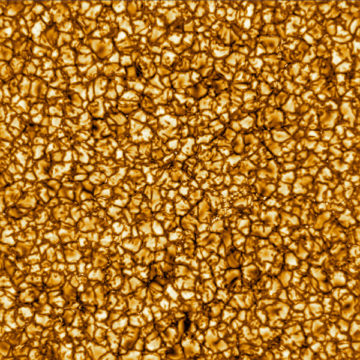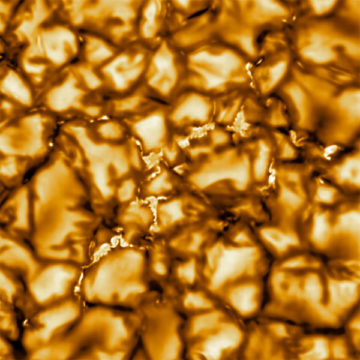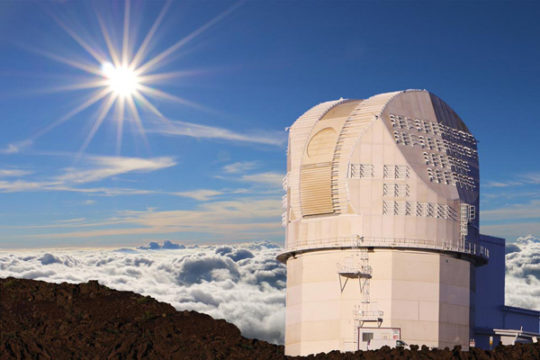The Daniel K. Inouye Solar Telescope has taken its first image of the Sun, a detailed view of our star's boiling gases that far surpasses what was possible before. Science operations are set to begin later this year.

NSO / NSF / AURA
And now the video version:
The Daniel K. Inouye Telescope, being built on Haleakalā in Hawai'i, has seen first light. The image above, taken using the Visible Broadband Imager (VBI), shows the Sun's boiling gases in unprecedented detail.
The convection cells, also termed granules, are roughly the size of Texas. The motions within each cell are akin to those in a pot of boiling water, with plasma welling up in the center of each cell, cooling near the surface, then sinking down the sides. In the process, each granule transports heat (and magnetic fields) from the Sun's interior into the outer atmosphere, or corona.
VBI's 16-megapixel camera can resolve features as small as 25 kilometers (15 miles) across — giving astronomers the power to resolve something the size of Manhattan on the surface of the Sun. "We’re so excited to be resolving the smallest details on the largest object in our solar system," says Thomas Rimmele, director of the Inouye Telescope.

NSO / NSF / AURA
And again, the mind-blowing video version:
"The first images that appeared on screen exceeded my expectations," Rimmele says. "Some people commented they had never seen me as happy as I was at that moment."
Inouye Telescope Timeline
Taken in December 2019, the first-light image kicks off the final sprint of a long marathon. Construction on the Inouye Telescope began almost a decade ago, with ground broken on December 12, 2012. Now, it will only be a few more months, likely in July 2020, until the telescope finally begins operations. While the VBI is in place, other instruments are still being commissioned.
The work will never really finish though — the observatory will remain a work in progress throughout the telescope's projected 44-year lifetime, as new instruments will take the place of outdated technology and keep the observatory on the cutting edge.
Over its long life, the telescope will see the Sun change throughout four solar cycles, the 11-year period over which our star's magnetic activity waxes and wanes. In fact, the telescope is beginning operations as the Sun is just ramping up Cycle 25.
The Corona, Unveiled
Up until now, ground-based telescopes observing the Sun have only been able to see the proverbial tip of the iceberg. The Sun's glare typically hides the corona from view except during a total solar eclipse, when, true to its name, the white light of ultra-hot plasma can be seen crowning the Sun.
With the new capabilities of the Inouye Telescope, astronomers will now be able to not only image the corona but even measure magnetic field lines as they twist and dance within the outflowing plasma. "It's all about the magnetic field," Rimmele says. Once all of the initial Inouye Telescope "To unravel the Sun's biggest mysteries, we have to not only be able to clearly see these tiny structures [granules] from 93 million miles away but very precisely measure their magnetic field strength and direction near the surface and trace the field as it extends out in the million-degree corona."
The Inouye Telescope's 4-meter (13-foot) mirror enables astronomers to collect a vast amount of sunlight, resulting in detailed images and other data that nicely complement the measurements made by NASA's Parker Solar Probe (currently on its fourth trip around and very near the Sun) and the European Space Agency's Solar Orbiter (to be launched February 6th).
Taking the Heat
Capturing first light was no easy feat. As Inouye collects all that sunlight, it's also collecting a lot of heat. If you've ever used a magnifying glass to set fire to dry kindling, you know the power of focused sunlight — now imagine using a magnifying glass 4 meters across!
Cooling the heat generated by the power of sunlight requires some neat engineering. The primary mirror itself is cooled to protect the surface. Then, after the primary mirror brings sunlight to a focus, the beam of light encounters a heat stop, a liquid-cooled metal donut that blocks 95% of the sunlight's heat before it hits the secondary mirror. The heat stop also basically acts as a field stop, shrinking the telescope's field of view to a circle 5 arcminutes across.
As engineers built the heat stop, they came across some roadblocks, so the heat stop used to take the first-light is a temporary one, requiring some restrictions on the pointing of the telescope. "We are looking at a second version of that that doesn’t have pointing restrictions," Rimmele says. "It’s in the works, and it will be resolved by the end of construction."
After the heat stop and the bounce off the secondary mirror, the drastically reduced beam of sunlight encounters a deformable mirror only 200 millimeters across with 1,600 actuators on the back that manipulate its shape. This mirror is part of a feedback system that removes the "twinkling" effect of Earth's atmosphere on the sunlight passing through it.
After this correction, the beam of sunlight bounces around the Coudé Lab, a 150-ton, rotating cleanroom that contains the scientific instruments that mine the sunlight for data. The instruments are expected to produce around 9 terabytes of data every day, providing a more detailed view of our star than we've ever had.
 0
0

Comments
You must be logged in to post a comment.